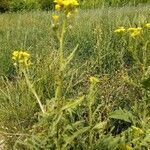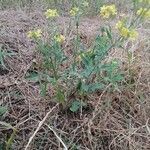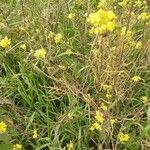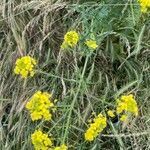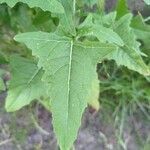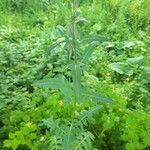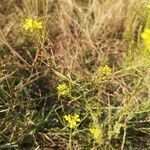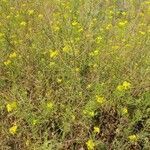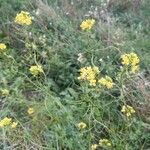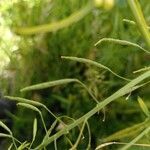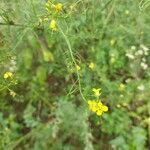Herbs annual, (20-)35-120(-175) cm tall. Stems erect, branched above, usually densely hispid below with retrorse trichomes, usually glabrous above. Basal leaves rosulate; petiole 1-4(-5) cm; leaf blade broadly oblanceolate in outline, runcinate-to lyrate-pinnatifid, (1.5-)2.5-8(-12) × (1-)2-5(-7) cm; lateral lobes 2-4 on each side of midvein, much smaller than terminal, entire or dentate; terminal lobe triangular, often hastate. Uppermost cauline leaves entire or toothed, much smaller than basal. Fruiting pedicels divaricate or ascending, slender, narrower than fruit, 0.5-1.2(-1.5) cm. Sepals oblong, ascending, 3-4 × 1-1.5 mm. Petals yellow, spatulate, 6-8 × 2-3 mm; claw subequaling sepals. Filaments yellowish, erect, 3-4.5 mm; anthers oblong, ca. 1 mm. Ovules 40-60 per ovary. Fruit narrowly linear, stout, terete, 2-3.5(-5) cm × 0.9-1.1 mm, curved or straight; valves often glabrous, slightly torulose; style stout, 0.3-0.7 mm; stigma prominently 2-lobed; septum slightly membranous. Seeds oblong, 0.7-1 × 0.5-0.6 mm, inserted in depressions of septum. Fl. May-Sep, fr. Jun-Oct. 2n = 14.
Erect, 5–12 dm, the stem generally reflexed-hirsute below; lower lvs lyrate-pinnatifid and dentate, usually hirsute, the lateral segments triangular to ovate, acute, spreading or deflexed, the terminal one larger, triangular; infl elongating progressively, the fls and buds overtopping the frs; sep 3–4 mm; pet lemon-yellow, 5–8 mm; anthers ca 1.5 mm; mature pedicels divergent, 5–20 mm; frs ascending to erect, slender, terete, 1.5–4 cm; 2n=14. Native of se. Europe and w. Asia, occasionally found in our range, and becoming a weed in w. U.S. June–Aug.
A cabbage family herb. It grows each year from seed. The stem is erect and 1 m tall. The leaves are divided into triangle shaped lobes. These have teeth along the edge. The flowers are bright yellow and at the top of the plant. The pod is 3.5 cm long and contains small seeds.
